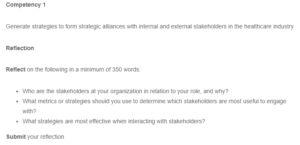Sector Stakeholders – Identifying and Cultivating Alliances
Stakeholders at Druid City Hospital (DCH)
The stakeholders in connection to my work as an employee at Druid City Hospital (DCH) in Tuscaloosa, Alabama, may consist of a variety of people and organizations interested in the smooth functioning and success of the hospital. The following are a few of the major DCH stakeholders:
Patients
Since they are the ones who get the hospital’s medical services, patients are the main stakeholders. We place the utmost value on their enjoyment, well-being, and successful outcomes. My responsibility as a healthcare practitioner centers on giving patients high-quality care, attending to their needs, and creating a great patient experience. Along with giving patients high-quality care, involving them in shared decision-making is crucial to ensure their active involvement in their healthcare process (Peterson & Heick, 2023). We can empower patients to make informed decisions and achieve better health outcomes by actively including them in their treatment plans and offering thorough education and support.
Hospital Administration and Leadership
The hospital’s executives and managers, as well as the hospital’s administration and leadership team, are crucial stakeholders. They decide how to allocate resources, develop policies and procedures, and determine the organization’s strategic direction. I may communicate with these parties as an employee to communicate, report, and coordinate my efforts with those of the hospital. To contribute to the hospital’s overall success, it is crucial for me as an employee to actively connect with them, giving updates on my progress, asking for advice when necessary, and coordinating my work with their objectives. Healthcare professionals (doctors, nurses, technicians), support staff (administrative, housekeeping), local community organizations and advocacy groups, insurers and payers, regulatory bodies, medical equipment and pharmaceutical suppliers, and others may be considered additional stakeholders. Each stakeholder contributes to the overall success and operation of DCH, and their cooperation and support are crucial to the smooth running of the hospital and the provision of high-quality healthcare services.
Metrics or Strategies to Determine the Most Useful Stakeholders
Several indicators and tactics can be used to decide which stakeholders are the most beneficial to interact with. It is critical to evaluate the stakeholders’ influence and impact on the hospital’s operations and objectives (Wackers et al., 2023). Engaging with stakeholders who significantly influence choices or provide resources is beneficial. Prioritizing engagement efforts can also be done by considering their level of interest and how much the hospital’s operations influence them. The selection process can be further guided by identifying stakeholders who share the hospital’s mission and strategic priorities, have knowledge or distinctive viewpoints pertinent to the organization, and are eager to work with and assist the hospital. Regular evaluation of stakeholders’ engagement outcomes and feedback, along with ongoing communication and relationship-building, can refine the approach and ensure the hospital effectively engages with the most valuable stakeholders.
Effective Strategies For Interacting With Stakeholders
Active listening, open communication, teamwork, relationship-building, and keeping promises are necessary for effective stakeholder interaction. Organizations can better grasp the wants and concerns of their stakeholders by actively listening to them. By ensuring that stakeholders have access to accurate and timely information, transparent communication helps to build credibility. Collaboration techniques give people a sense of ownership and enable them to share their knowledge by including them in decision-making. Long-term involvement and goodwill are fostered through establishing close connections with stakeholders and acknowledging their contributions. Finally, keeping promises shows dependability and accountability, which increases stakeholder trust. Implementing these strategies enables organizations to foster meaningful and productive engagement with their stakeholders, leading to mutually beneficial outcomes.
References
Peterson, S., & Heick, J. (2023). Referral Decision Making and Care Continuity in Physical Therapist Practice. Physical Therapy. https://doi.org/10.1093/ptj/pzad030
Wackers, E., Dulmen, S. V., Berden, B., Kremer, J., Stadhouders, N., & Jeurissen, P. (2023). Improving Performance in Complex Surroundings: A Mixed Methods Evaluation of Two Hospital Strategies in the Netherlands. International Journal of Health Policy and Management, 12(Issue 1), 1–12. https://doi.org/10.34172/ijhpm.2023.7243
ORDER A PLAGIARISM-FREE PAPER HERE
We’ll write everything from scratch
Question

Sector Stakeholders – Identifying and Cultivating Alliances
Competency 1
Generate strategies to form strategic alliances with internal and external stakeholders in the healthcare industry.
Reflection
Reflect on the following in a minimum of 350 words:
- Who are the stakeholders at your organization in relation to your role, and why?
- What metrics or strategies should you use to determine which stakeholders are most useful to engage with?
- What strategies are most effective when interacting with stakeholders?
Submit your reflection

